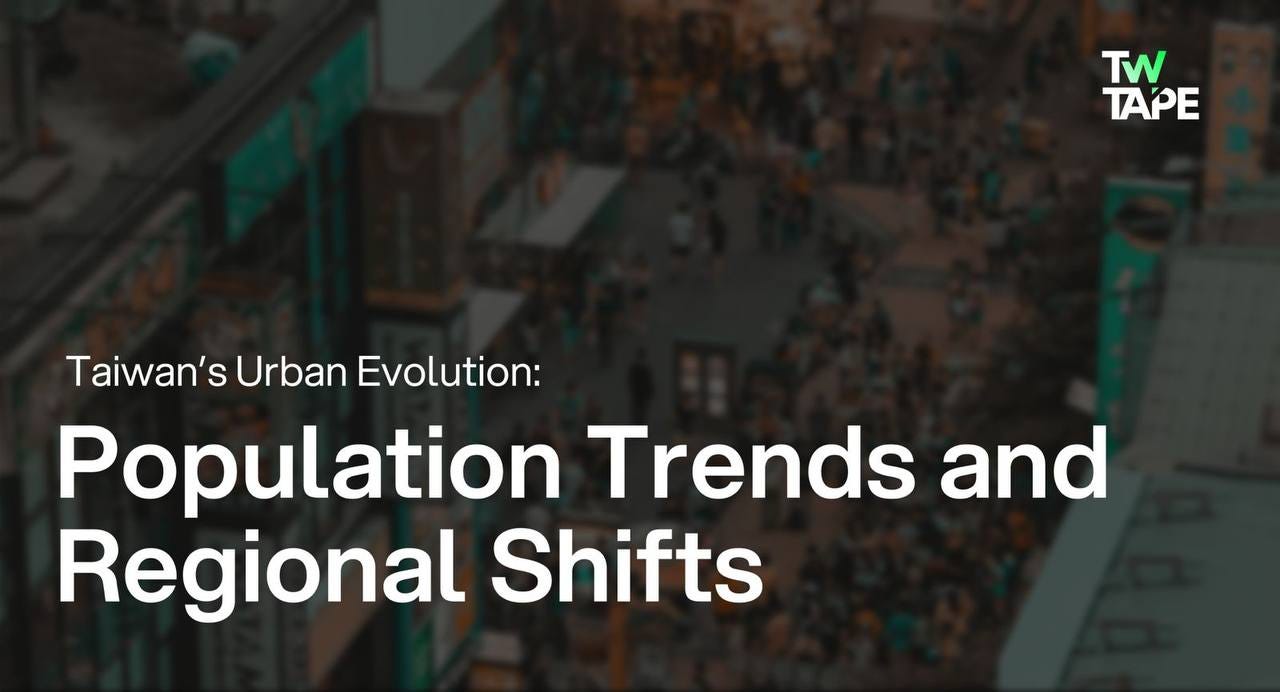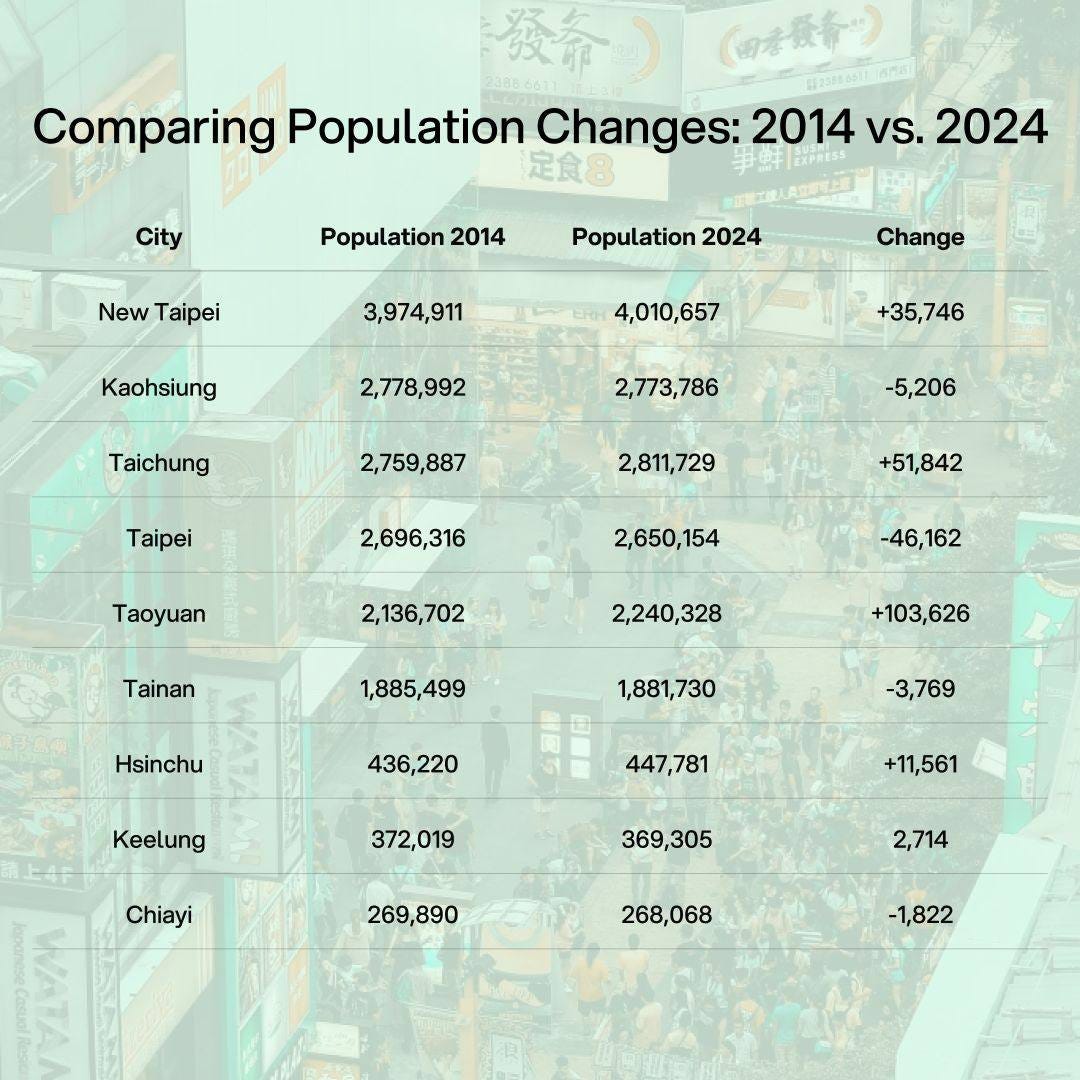Taiwan is known for its busy cities and rich culture. Over the last ten years, the population in its major cities has changed a lot due to urban growth, job opportunities, and shifts in demographics. This article explores the population dynamics of Taiwan's major cities from 2014 to 2024, providing insights into growth patterns, regional changes, and the factors influencing these developments.
Comparing Population Changes: 2014 vs. 2024
Each of Taiwan’s major cities has its own unique role, combining cultural heritage with economic and technological strengths. New Taipei City, the most populous with 4,010,657 residents, acts as a suburban extension of Taipei, drawing families and commuters with its affordable housing and excellent transportation.
Kaohsiung, home to 2,773,786 people, is shifting away from heavy industry toward a more diverse economy that emphasizes tourism and renewable energy. Taichung, with a population of 2,811,729, is known as a cultural center, boasting a mild climate and a focus on sustainable urban development.
Taipei City, the capital with 2,650,154 residents, remains the political and economic heart of Taiwan, even as high living costs drive some people to move elsewhere. Taoyuan, home to 2,240,328 people, has grown as an industrial and logistics hub, while Tainan’s 1,881,730 residents enjoy its rich history and tourism-driven economy.
Hsinchu, known as Taiwan’s “Silicon Valley,” has a population of 447,781 and continues to expand thanks to its booming tech sector. In contrast, Keelung, with 369,305 residents, and Chiayi, with 268,068, experience slower growth due to their focus on maritime and agricultural industries.
Growth:
Taichung and Taoyuan experienced the largest population growth. Taoyuan’s booming industrial sector and Taichung’s central location and strong economy have been key drivers of this trend. Both cities have also focused on improving infrastructure and promoting sustainable urban development.
Declining Cities:
Taipei and Kaohsiung saw population declines due to suburbanization, industrial changes, and younger people moving to other cities for better opportunities. High living costs in Taipei and economic shifts in Kaohsiung were major factors behind these trends.
Urbanization and Suburbanization
Taiwan’s urbanization and suburbanization trends are shaped by economic, social, and infrastructural developments. Taoyuan, for instance, has experienced substantial growth due to its role as an industrial hub and its strategic proximity to Taiwan Taoyuan International Airport.
The city’s population rose by over 103,000 between 2014 and 2024, driven by the expansion of industrial parks and the presence of global tech companies. Similarly, New Taipei City has emerged as a suburban extension of Taipei, offering more affordable housing and better access to the capital through robust transportation networks like the Taipei Metro and intercity railways. This connectivity has encouraged families and commuters to relocate, contributing to its population increase of 35,746 over the same period.
In contrast, Taipei City has faced population declines due to its high living costs, which have risen significantly over the decade. Between 2014 and 2024, the cost of living in Taipei increased by approximately 20%, driven by soaring real estate prices and inflation in essential goods and services. These economic pressures have driven many residents to seek alternatives in nearby suburbs.
New Taipei has absorbed much of this outflow, becoming a magnet for those looking for a balance between urban amenities and affordable living. The suburban shift, enabled by expanding infrastructure and housing developments, illustrates how affordability and connectivity are reshaping Taiwan’s metropolitan regions.
Economic Shifts
Economic opportunities strongly influence population trends, with cities like Hsinchu and Taoyuan seeing growth due to their thriving industries. Hsinchu, known as Taiwan’s “Silicon Valley,” has seen steady population increases as tech companies like TSMC expand their operations. Between 2014 and 2024, over 25 high-tech factories and research centers were established in the city, further cementing its status as a global tech hub and drawing thousands of skilled workers.
Taoyuan’s industrial growth, particularly in logistics and manufacturing, has similarly spurred population growth. The city’s industrial parks house more than 4,000 companies as of 2024, including major global players, making it one of Taiwan’s fastest-growing regions.
In contrast, Kaohsiung has faced population challenges due to the decline of traditional heavy industries, such as steel and shipbuilding, which collectively saw a reduction in output by nearly 30% between 2014 and 2024. The number of operational steel plants and shipyards in the city dropped by approximately 20% over this period, reflecting broader shifts in global manufacturing and trade patterns. Efforts to diversify into tourism and creative sectors have been slow to compensate for the loss of industrial jobs, resulting in a net population decline and slower economic recovery.
Aging Population
Taiwan’s aging population is a key factor influencing demographic shifts. Smaller cities like Chiayi and Keelung, which lack robust economic opportunities, are seeing younger generations migrate to larger urban centers in search of better prospects. This demographic imbalance has left these cities with older populations and slower economic growth.
National statistics highlight that by 2024, over 16% of Taiwan’s population was aged 65 or older, with smaller cities experiencing the most pronounced aging trends. For instance, Chiayi’s slower economy has led to consistent out-migration among youth, while Keelung faces similar challenges due to its limited diversification beyond port-related industries.
Taoyuan and Taichung Rise in Population
Rising living costs in Taipei and shifts in industrial production have pushed many residents to seek opportunities in cities that offer a better balance between affordability and employment stability. This has led to significant population growth in cities like Taoyuan and Taichung, where thriving industries, economic opportunities, and sustainable urban development make them attractive destinations for workers and families.
However, this trend has also created challenges for other cities facing stagnant or declining populations. With fewer people in the productive age range (20s to 40s), many cities outside of high-growth areas like Taoyuan and Taichung are struggling with workforce shortages. This imbalance could hinder economic development and exacerbate regional disparities in the long term.



